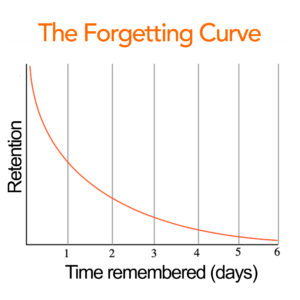
What do you do when you need to learn something?
Hello, it’s Shan Shan here. In this post, I’ll show you some of the most effective practices I use whenever I try to learn something new. These aren’t a collection of learning tips I quickly googled but are all based on my own learning experience.
When I first went to university, these practices helped me transform from an average to a top student. They’ve helped me gain prestigious professional accreditations. And they’ve helped me learn the knowledge and skills I needed to set up my business and realise a lifelong dream.
I discovered them more than a decade ago and have refined them through trial and error. As I’ve learned more about the science of the brain and memory, I’ve become fascinated with why these practices work and how to make the best use of them.
If you’ve never thought about how to learn effectively, this is an excellent place to start. And if you’ve already started learning how to learn, it would be great to compare notes with you.
Let’s dive straight in.
1. Learning by teaching
This learning technique has several names, including the Feynman method, active recall and creative rehearsal. I’ve been using it since I was in primary school, without knowing it was such a powerful learning tool.
I naturally started studying in this way because I wanted to be a teacher. So, I would go home after school and teach what I had learned that day to my imaginary class.
There are two simple steps to follow when you use this technique:
Step one
Try to understand and absorb something by reading the original materials, going over the notes, rewriting them, and summarising them into bullet points. When I do this, I talk to myself in my head to help make sense of the information.
Step two
Without looking at your notes, teach what you’ve learned to someone else or a wall (which is much easier). Make sure you speak out loud and use your own logic and words to explain it. Don’t worry if you forget something the first couple of times as this is normal. When I do, I simply skip the bit I can’t explain and continue to the end. Then I check my notes and try again.
Why does this method work so well?
Firstly, this learning by teaching strategy requires you to fully understand and internalise the material before you present it to an audience. Secondly, you must retrieve the information. Lastly, but by no means least, you’re using multiple senses as you learn: vision when you first study the materials and hearing when you speak out loud to teach them.
2. Spaced repetition
This technique will improve your brain’s ability to recall what you learn. It works because our brains learn more effectively when we space out our learning over time instead of cramming it all into one day.
This is because we naturally forget. In some cases, we only retain about 30% of what we learned one day ago. So, to make sure we store the information in our long-term memory from where we can easily retrieve it, we need to review it frequently (beat the forgetting curve).

I didn’t fully appreciate the importance of this practice when I was a student. Because I had weekly lectures on the subjects I was learning, it was built into the system that I would review information regularly.
However, when I started to pursue self-directed study to deepen my understanding of how to get better at learning, I didn’t progress as well as I expected. Instead, I found myself re-learning the same things over and over again. I would learn new information, completely forget it, re-learn it, and forget it again…
Eventually, I realised that I didn’t review my learning and make it stick in my memory. To my amazement, I discovered studies that explored the optimal gap between learning sessions to maximise our memory. However, this can get super complicated, with different times for different tests.
A simpler version is to re-learn information at the end of one day, one week, two weeks and one month. These time frames are approximate, so it’s essential to try them out and revise them to what works best for you. For example, after I learn something, I review it at the end of the day and then every week for another four weeks.
3. The 50+10 formula
You know this one and have had it integrated into your practice for a long time. It’s to study for 50 minutes and then have a 10-minute break.
Even when I was at university, we had the old-style school bell. It rang at 08:00 for the first class, 08:50 for the first break, 09:00 for the next class, and repeated this pattern until the end of the day. I still follow this pattern to organise my learning schedule today.
For example, if I have half a day to learn something, I’ll split my time into three or four sessions, each with a realistic learning goal. When the 50 minutes are up, I take a break, leave my desk, move around and get some fresh air and water. If I haven’t achieved the learning goal, I still take a break rather than push on. The chances are I won’t be able to complete what I set out to accomplish if I carry on for another five minutes anyway. So I stop and decide when it’s appropriate to work towards this learning goal again.
It’s no coincidence that this 50/10 pattern is used in classrooms around the world. Studies on work productivity suggest the rule of 52/17: work with purpose for 52 minutes and take a break for 17. If you have less time, the POMODORO technique with 25 minutes of working time is another option.
4. Sleep on it
No, this isn’t a typo. But it also doesn’t mean you should put your learning notes under your pillow. Instead, it means to go over the materials you want to memorise just before you go to sleep.
This practice is especially helpful when you’re preparing for an exam (university and professional), getting ready for a presentation or speech, or need to recall information quickly.
To be clear, this practice is not for cramming. I’m not suggesting you pull an all-nighter in bed. It will only work when you’ve already learned and understood the materials.
When I’m preparing for an exam or presentation, I practice it for three nights beforehand, for 10 to 20 minutes each night. This is what I do:
- Get ready for bed as usual
- Look through the ‘difficult’ information I want to memorise (I’ve already studied the materials during the day)
- Go to bed and turn off the lights (my eyes are closed, but I’m focusing on the information)
- Review in my mind everything I just scanned through
- Skip any details I can’t remember
- Check the part I can’t recall if I haven’t fallen asleep before I complete the review
If I fall asleep before I’ve reviewed all the details, it’s ok. I just start from the end the next night. The result? The following day the information is imprinted on my brain, and I can recall it much more quickly and easily.
I discovered this practice when I was at university. Years later, I read a study of Harvard University students on how learning before sleep is more effective since sleep is crucial for memory consolidation. When we fall asleep, the part of our brain called the hippocampus, which is in charge of creating and storing our memories, becomes very active. Intentionally putting new information in our heads just before we go to sleep encourages this crucial step in consolidating what we remember and therefore can recall. So it’s the sleep that makes all the difference.
5. Take a walk
Compared to the previous four strategies, which all align the learning activity with the way the brain works, this practice is about how you can upgrade your brain.
Extensive studies suggest that exercise can improve cognitive function and academic performance, increase productivity, reduce mental fatigue and have other positive effects on our psychological and social wellbeing. Plus, the impact is immediate.
A simple and powerful way to take care of your brain is to take a walk every day. I always include a brisk 10 – 20-minute walk on my way to work, the shops or around the village where I live. Best of all, you don’t need any fancy shoes or equipment.
Research shows that interacting with nature can improve your ability to focus and concentrate for longer. So I try and take green routes where there are trees and grass. Sometimes I walk more slowly and stop to take photos to help me engage with the nature that’s around me.
Of course, there are rainy days when you won’t feel like walking and busy days when you feel like you don’t have time. On these days, I encourage myself by imagining all the new cells that are being generated in my brain or asking, What would the best version of Shan Shan do in this situation? Most of the time, they do the trick.
So that’s it – these are some of the practices I use when I learn.
Which ONE will you use to get better at learning?
Join my free video workshop
Join my workshop, Five Days to Activate Your Learning Potential. I’ll show you how to get ready to learn fast, remember more and grow your own learning superpower.
You might think this is just for students, but it’s not. We’re all lifelong learners with the potential to gain new skills and knowledge as we become our best selves. So carve out a little bit of time today to listen to this free workshop.
